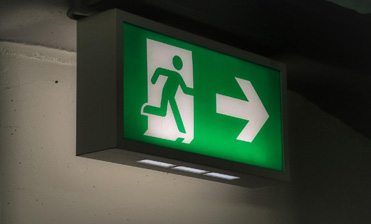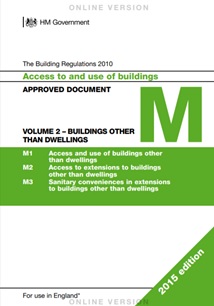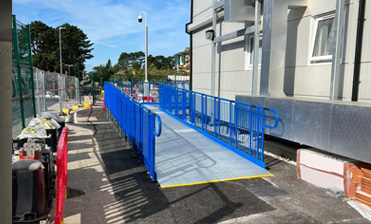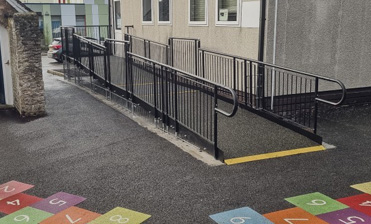
Published on Monday 12th September 2022
An inclusive design should be implemented from the earliest phases of a building project (design and planning) and considered throughout to ensure standards are maintained. Within the design, the types of signage, lighting, visual contrasts and materials should be reviewed, as well as how access to the building will be accomplished.
An inclusive design should be implemented from the earliest phases of a building project (design and planning) and considered throughout to ensure standards are maintained. Within the design, the types of signage, lighting, visual contrasts and materials should be reviewed, as well as how access to the building will be accomplished.
Professionals such as architects, planners, surveyors, building control surveyors, facilities managers, access equipment providers, and engineers often participate in the design and planning stages. However, ultimately the responsibility falls on the property owners, developers, and service providers to comply with the necessary regulations to achieve a compliant inclusive environment.
Guidelines to be aware of:
- Documents M & K of the Building Regulations – Regarding access ramps, a dwelling ramp should have a minimum width of 900mm and often can accomplish a gradient of 1:12.
Public access ramps should achieve a minimum width of 1500mm and often can accomplish a minimum gradient of 1:15 or 1:20 gradient is frequently specified.
The maximum gradient that your ramp can reach is determined by the change in rise (aka the height) to overcome.
If the maximum gradient has been reached, a resting platform must be provided to allow the user to pause, as they may become tired and out of breath.
Diagram – The relationship of ramp gradient to the going of a flight
.jpg)
.jpg)
>More Information on Building Regulations<
- The Equalities Act 2010 - The act protects a person against discrimination on the grounds of disability, age, gender, race, religion, or sexual orientation
Regarding accessibility, the Act requires employers, local authorities, schools, and service providers to make reasonable adjustments for disabled people by removing barriers (such as steps) that could stop individuals from gaining and remaining in employment or education; or customers from accessing and using goods and services. >More Information on The Equalities Act<
- The Regulatory Reform (Fire Safety) Order 2005 (applicable in England and Wales) - Applies to all public and commercial buildings, structures, and open spaces. >More Information on Fire Safety Order<
-The Building Bulletin 100 (BB 100) produced by the Department for Education - The guidance covers life safety (compliance with the Building Regulations), school-specific fire risks, property protection and fire safety management (p6). >More Information The Building Bulletin 100 (BB 100)<
Wheelchair Access
The access specification standards differ depending on the type of building being considered. A public building will require greater safety provisions than a private residential building because individuals could be unfamiliar with a public building layout, and higher levels of daily users are expected.
Plus, wheelchair access often can only be achieved when physical barriers are removed. Physical barriers can include steps, stairways, kerbs, exterior surfaces, paving building entrances and exits (including emergency escape routes), and internal and external doors.
Ramps are frequently used to overcome physical barriers. Please note the system must adhere to both Part M and K of the Building Regulations; however, if there is a conflict between the guidance, then Part M takes precedence.
Fire Safety
Everyone, including disabled people, has the right to access safe escape routes and exits in the event of a fire. Those with disabilities and wheelchair users are considered especially at risk.
Some factors to consider:
- Ensure to have audible and visual alarms to assist the deaf and blind.
- Part M, Section 1B of the Building Regulations states that an entrance door should have a minimum clear opening width of 775mm, and Ideally, the door opening should be 900mm wide for a wheelchair user.
- Disabled individuals should be located on the ground floor, preferably. Avoid parts of the premises where it would be difficult for them, even with help, to escape in the event of a fire.
- An access system from a fire door must be non-combustible, such as a metal ramp or steps. Wooden systems will burn if exposed to fire.
Other Useful Links:
How to make an event accessible for disabled
How to create an accessible workplace for disabled people
Fire safety design regulations for schools
DO YOU NEED RAMPS & STEPS?
Request a quick quote or email [email protected] with the full project address, drawings, photos and contact details.
THE UK’S EXPERTS IN MODULAR RAMP SYSTEMS.
Rapid Ramp
Riverside Works, Church Ln, Etchingham, TN19 7AS
Hours:
8am - 5pm, Monday to Friday



.jpg)
.jpg)
.JPG)
%20Order%202005.jpg)
(1).jpg)

